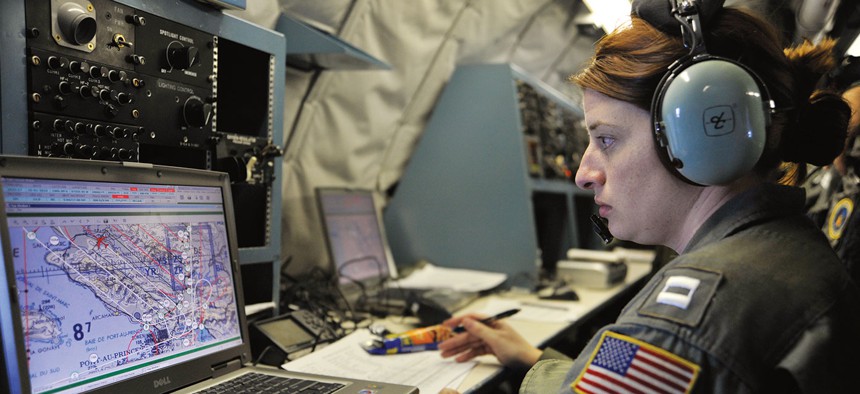
The military is weighing new weapons guidance tools to counter GPS jammers. Perry Aston/USAF
Beyond GPS
As opponents have developed more powerful jammers, U.S. leaders are looking for new navigational technologies.
Air Force pilots streaked through the sky during a recent war game, bearing down on an enemy stronghold, until they realized their target was heavily defended by the invisible radio waves of a GPS jammer. The realization was a mission stopper. Such devices can cause bombs to miss their targets, or worse, divert them and cause unintended civilian casualties. And that, in the age of Twitter, can change the course of a war.
In years past, training directors would have turned off their real or simulated jammers and sent the pilots around again for their “real” bombing run. The threat of jamming, it was thought, was too remote to actually train for.
That has changed. Today, military planners have come to expect jamming everywhere. High-end militaries like Russia and China are thought to have developed and deployed powerful anti-GPS equipment, while loosely organized militias can order $100 jammers online and plug them into a car’s cigarette lighter.
The need to counter these systems has changed how the military develops new equipment, weapons and tactics.
“It used to be that we had no answers” to GPS jamming, says Josh Hartman, a former deputy assistant secretary for space and intelligence at the Pentagon who is now a partner at Renaissance Strategic Advisors, a Virginia-based consulting firm. “We now have answers and we have opportunities to continue to make the exercises valuable by telling the folks to continue to conduct their missions in a GPS-denied environment.”
For decades, every U.S. military operation has relied on GPS, whether delivering humanitarian aid to earthquake victims in Nepal or dropping bombs on Islamic State defenders in Syria. Precise positioning data from the Air Force’s 24 GPS satellites orbiting the Earth communicate with military aircraft, tanks, ships, radios, weapons and other gear around the clock, 365 days a year.
Since the military will likely continue to rely on GPS for decades to come, it is building a new constellation of satellites that use a special signal more resistant to jamming and spoofing. But leaders are also weighing new navigational technologies that don’t rely on orbital aid, including an atomic clock shrunk to fit on a computer chip.
That technology “gives you that accurate timing all the time,” says Gen. John Hyten, who heads Air Force Space Command. The chip-set atomic clock is close to maturation, and could be usable as soon as the end of the decade.
In a speech at Stanford University earlier this year, Defense Secretary Ashton Carter said the military was hunting for GPS alternatives that are more resilient and less vulnerable. “We’ll do that in part by advancing microelectromechanical systems technology for small inertial navigation units, small accurate accelerometers, and precision clocks—all on a chip,” he said.
Such technology could allow all military systems to “keep track of their position, orientation, and time from the moment they are created with no need for updates from satellites,” Carter said.
Less Interference
This kind of technology already exists on smartphones, but the Pentagon needs it to be more precise before it can guide weapons. The Army is already looking to use it in some of its new vehicles. The chips won’t replace satellites; indeed, part of the effort includes building better orbiting navigational systems that are less susceptible to enemy interference.
“I think that GPS is going to exist and it’s going to be the gold standard,” Hyten says.
The Air Force has talked about adding more power to its GPS satellites, making the small jamming devices less effective, Hartman says, but an enemy could counter those efforts with more powerful jammers. “I personally believe, having watched the technology play out, that the biggest gains are going to be in the user equipment area,” he says, referring to improvements in GPS receivers on the ground and in the air—inside vehicles, aircraft and radios.
New electronics gear could simply incorporate new technology, whether it’s more powerful GPS receivers or atomic navigation chips. But retrofitting existing equipment could prove pricey. Experts estimate the military has between 5 million and 10 million pieces of equipment, maybe more, that rely on satellite navigation. That includes most bombs and other aerial munitions as well as gear carried by soldiers and Marines.
“That’s going to be a very hard thing to do because it will take money and all the services will have to look at their infrastructure,” Hyten says.
Until the new equipment and technology reaches the battlefield, those same pilots who used to give up on practice runs will have to find new tactics and different types of precision weapons to hit targets guarded by GPS jammers.
NEXT STORY: Data Gurus Take Charge







